ATOMIC STRUCTURE PDF
INTRODUCTION:
(BASIC ATOMIC STRUCTURE) All matters are in nature is made up of only a few elements. The elements exist as atoms and/or molecules. Molecules of an atom are made up of atoms of the same type. Compounds contain two or more elements. Thus, the molecules of compounds contain atoms of different elements.
MODEL OF AN ATOM: ( BASIC ATOMIC STRUCTURE)
(BASIC ATOMIC STRUCTURE) Atoms are too small to see even with a powerful microscope and too light to be weighed even on the most sensitive balance. The history of the discovery of the structure of an atom is fascinating but a complicated subject. Only 100 years ago, scientists believed that atoms were solid, indestructible particles. Since then many great scientists had contributed brilliantly to give us the today’s model of an atom. Over the centuries, many philosophers and scientists tried to develop a model of the atom.
SOME IMPORTANT ATOMIC MODELS ARE DESCRIBED HERE ( BASIC ATOMIC STRUCTURE)
| NAME OF THE SCIENTIST | STATEMENT | POSTULATE/THEORY | DIAGRAM |
| (i)MAHARISHI KANAD | If a pure substance is broken down into smaller pieces, a stage is reached when no further subdivision is possible. | 1)Ultimate smallest particle of any pure substance as anu having same properties in each anu.
2)Anu may be made of two or more still smaller particles called paramanuwhich is the ultimate smallest unit of matter. |
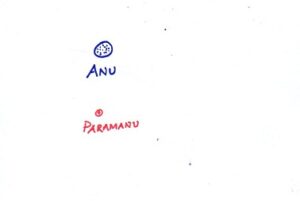 |
| (ii) GREEK PHILOSOPHERS like DEMOCRITUS (400-500B.C.) | Tiny particles of matter is termed as Atom (in greek word atomosmeans uncut) | There was no experimental evidence to support this model. |  |
| (iii)English school teacher JOHN DALTON (1805) | He proposed a model of an atom. This is well known as Dalton’s Atomic Theory. | Main postulates are-
· All matters are made up of very small particles called atom. · Atoms cannot be divided ; it can not be changed into another form. · Atoms retain their identity during any chemical reaction. · Atoms combine in the ratio of whole numbers (1:1, 1:2, 2:3)to form compound atoms which are identical in all properties in a particular element, and differ from those of the other substances. |
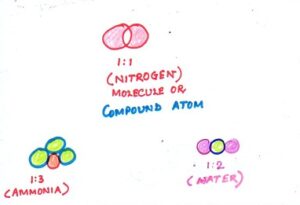 |
| (iv) J.J.THOMPSON
(1898) |
Plum pudding model of an Atom. | ü Atom isimaginary to be considered as a structure of a plum pudding where mass of similar amount of positive charge and negatively charged electrons are embedded into it ,as resins and nuts.
ü In an atom,the amount of positive charge is equal to the total negative charge . |
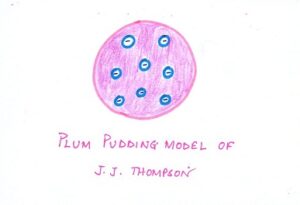 |
| (v) RUTHERFORD and GOLDSTEIN. | Goldstein bombarded a thin sheet of a gold foil with ᾳ(alpha) particles in an evacuated chambers. The conclusions are:
· The central part of an atom is heavy and positively charge with large amount of empty or hollow space. · The entire mass of an atom is concentrated inside it’s nucleus. |
On famous ᾳ-particle scattering experiment RUTHERFORD postulated the following statements:
Ø An atom consists of the following sub-atomic particles like: proton (positively charged) neutron (neutral)and electron (negatively charged). Ø Electrons surrounds the Nucleus and due to the presence of electrostatic force all particles are held firmely. Ø The size of the nucleus is very minute. |
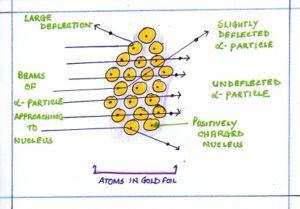 |
| (v) NEIL BOHR (1913) | He proposed a brilliant description on Bohr’s Atomic Model. | Various postulates are :
· In an atom, the electron revolves around the nucleus in certain definite circular paths called orbit and shell. · Each circular orbit consists of a definite amount of energy known as energy levels or energy shells. · The maximum number of electrons which can be accommodated in a given orbit by the formula 2n2, where n is the quantum number of the orbit. |
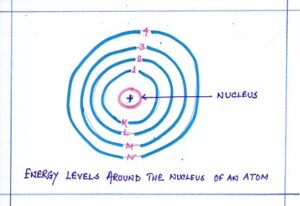 |
Here is the designation of the orbit and maximum number of electrons present in the shell. ( BASIC ATOMIC STRUCTURE)
| Shell number (n) | Designation of orbit | Maximum number of electron (2n2) |
| 1 | K | 2 X 12 = 2 |
| 2 | L | 2 X 2 2=8 |
| 3 | M | 2 X 32 =18 |
| 4 | N | 2 X 4 2=32 |
According to Bohr-Bury scheme, the shell corresponding to n=1 (k shell) will have 2 electrons and … so on.
INSIDE ATOM: Atoms are the main building blocks of matter. Inside the atoms, there are present a variety of even tinier particles called sub-atomic particles: Protons, Neutrons, and Electrons.
An atom has central part called nucleus containing the sub-atomic particles protons and neutrons. Outside the nucleus electrons revolve around the nucleus in definite orbits known as energy shell.
In 1913, Mosely introduced ATOMIC PARAMETER:
- ATOMIC NUMBER: It is equal to the number of protons present inside the nucleus of its atom. It is denoted by Z = No. of proton (P)
- MASS NUMBER: It is equal to the sum of the number of proton (P)and number of neutron(N) present inside the nucleus. It is denoted by A = P + N
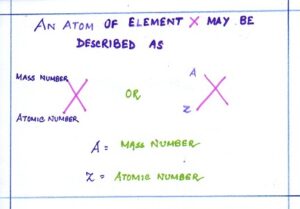
- ATOMIC MASS: The average mass of an atom of an element in atomic mass units is called atomic mass. It may be fractional like atomic mass of Oygen = 168O = 15.999
| SYMBOL NAME | ELEMENT NAME | ATOMIC NUMBER (Z) | MASS NUMBER (A) | NEUTRON (N) | PROTON (P) | ELECTRON (E) | ELECTRONIC CONFIGURATION |
| H | Hydrogen | 1 | 1 | 0 | 1 | 1 | 1 |
| He | Helium | 2 | 4 | 2 | 2 | 2 | 2 |
| Li | Lithium | 3 | 7 | 4 | 3 | 3 | 2,1 |
| Be | Beryllium | 4 | 9 | 5 | 4 | 4 | 2,2 |
| B | Boron | 5 | 11 | 6 | 5 | 5 | 2,3 |
| C | Carbon | 6 | 12 | 6 | 5 | 5 | 2,4 |
| N | Nitrogen | 7 | 14 | 7 | 7 | 7 | 2,5 |
| O | Oxygen | 8 | 16 | 8 | 8 | 8 | 2,6 |
| F | Fluorine | 9 | 19 | 10 | 9 | 9 | 2,7 |
| Ne | Neon | 10 | 20 | 10 | 10 | 10 | 2,8 |
| Na | Sodium | 11 | 23 | 12 | 11 | 11 | 2,8,1 |
| Mg | Magnesium | 12 | 24 | 12 | 12 | 12 | 2,8,2 |
| Ca | Aluminium | 13 | 27 | 14 | 13 | 13 | 2,8,3 |
| Si | Silicon | 14 | 28 | 14 | 14 | 14 | 2,8,4 |
| P | Phosphorus | 15 | 31 | 16 | 15 | 15 | 2,8,5 |
| S | Sulphur | 16 | 32 | 16 | 16 | 16 | 2,8,6 |
| Cl | Chlorine | 17 | 35 | 18 | 17 | 17 | 2,8,7 |
| Ar | Argon | 18 | 40 | 22 | 18 | 18 | 2,8,8 |
| K | Potassium | 19 | 39 | 20 | 19 | 19 | 2,8,8,1 |
| Ca | Calcium | 20 | 40 | 20 | 20 | 20 | 2,8,8,2 |
ATOMICITY: It is defined as the number of atoms present in a molecule of an element. This phenomenon is of four types:
| TYPE OF ATOMICITY | EXAMPLE |
| Monoatomic molecule (exists in isolated form) | Helium (He)
Neon (Ne) Argon (Ar) Krypton (Kr) |
| Diatomic molecule (contains two atoms combined together) | Hydrogen (H2)
Nitrogen (N2) Oxygen (O2) Chlorine (Cl2) |
| Triatomic molecule (contains three atoms combined together) | Ozone (O3) |
VALENCE ELECTRON: Electron in the outermost shell of an atom are called its valence electron. For example, atomic numer of Sodium is 11, so its electronic configuration: K 2 L8 M1
The outermost shell of Sodium atom contain only one electron, so numer of valence electron inNa is 1. ( BASIC ATOMIC STRUCTURE)
ELECTRON DOT STRUCTURE: ( BASIC ATOMIC STRUCTURE) This method was introduced y an American Chemist G. N. Lewis. By this method an atom of any elementcan be represented. The symbol of the element represents nucleus and electrons in inner shell. The dots on the symbol represents the number of valence electrons in that atom.
SOME EXAMPLES ONE:
| ELEMENT | SYMBOL | ELECTRONIC CONFIGURATION | DOT STRUCTURE |
| Sodium | Na | 2,8,1 | 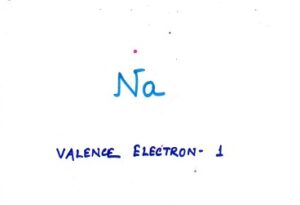 |
| Magnesium | Mg | 2,8,2 | 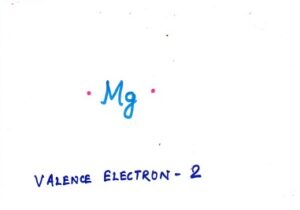 |
| Aluminium | Al | 2,8,3 | 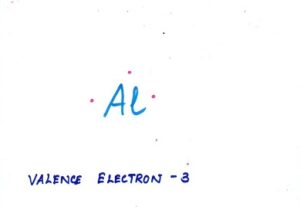 |
| Chlorine | Cl | 2,8,7 | 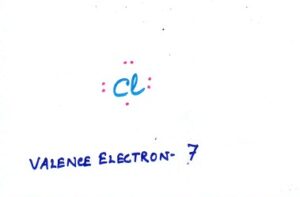 |
| Oxygen | O | 2,6 | 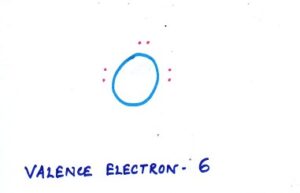 |
| Phosphorus | P | 2,8,5 | 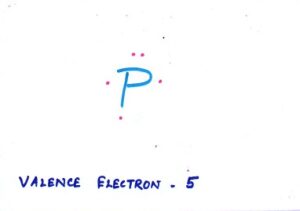 |
ELECTRONIC VALENCY: The combining capacity of an element can e descried by the number of valence electron. Valency is the number of valence electrons of an element which actually take part in any chemical reaction. The valency of an element is:
- Equal to the number of valence electron.
- Equal to the eight minus the number of valence electron.
VARIABLE VALENCY: Certain elements show more than one valency. Such elements are having variable valence. ( BASIC ATOMIC STRUCTURE)
| ION | NAME | NOW WRITTEN AS |
| Cu+ | Cuprous ion | Cu (I) ion |
| Cu2+ | Cupric ion | Cu (II) ion |
| Fe2+ | Ferrous ion | Fe (I) ion |
| Fe3+ | Ferric ion | Fe (II) ion |
The chemical reactivity of an element depends upon its electronic configuration. The noble gases – Helium, Neon, Argon etc do not show any chemical reactivity. Therefore, it can be said that elements having incomplete outermost shell are reactive.
INTRODUCTION: (BASIC ATOMIC STRUCTURE) All matters are in nature is made up of only a few elements. The elements exist as atoms and/or molecules. Molecules of an atom are made up of the atoms of the same type. Compounds contain two or more elements. Thus, the molecules of compounds contain atoms of different elements.
MODEL OF AN ATOM: (BASIC ATOMIC STRUCTURE) Atoms are too small to see even with a powerful microscope, and too light to be weighed even on the most sensitive balance. The history of the discovery of the structure of an atom is fascinating but a complicated subject. Only 100 years ago, scientists believed that atoms were solid, indestructible particles. Since then many great scientists had contributed brilliantly to give us the today’s model of an atom. Over the centuries, many philosophers and scientists tried to develop a model of the atom.
SOME IMPORTANT ATOMIC MODELS ARE DESCRIBED HERE
| NAME OF THE SCIENTIST | STATEMENT | POSTULATE/THEORY | DIAGRAM |
| (i)MAHARISHI KANAD | If a pure substance is broken down into smaller pieces, a stage is reached when no further subdivision is possible. | 1)Ultimate smallest particle of any pure substance as anu having same properties in each anu.
2)Anu may be made of two or more still smaller particles called paramanuwhich is the ultimate smallest unit of matter. |
 |
| (ii) GREEK PHILOSOPHERS like DEMOCRITUS (400-500B.C.) | Tiny particles of matter is termed as Atom (in greek word atomosmeans uncut) | There was no experimental evidence to support this model. |  |
| (iii)English school teacher JOHN DALTON (1805) | He proposed a model of an atom. This is well known as Dalton’s Atomic Theory. | Main postulates are-
· All matters are made up of very small particles called atom. · Atoms cannot be divided ; it can not be changed into another form. · Atoms retain their identity during any chemical reaction. · Atoms combine in the ratio of whole numbers (1:1, 1:2, 2:3)to form compound atoms which are identical in all properties in a particular element, and differ from those of the other substances. |
 |
| (iv) J.J.THOMPSON
(1898) |
Plum pudding model of an Atom. | ü Atom isimaginary to be considered as a structure of a plum pudding where mass of similar amount of positive charge and negatively charged electrons are embedded into it ,as resins and nuts.
ü In an atom,the amount of positive charge is equal to the total negative charge . |
 |
| (v) RUTHERFORD and GOLDSTEIN. | Goldstein bombarded a thin sheet of a gold foil with ᾳ(alpha) particles in an evacuated chambers. The conclusions are:
· The central part of an atom is heavy and positively charge with large amount of empty or hollow space. · The entire mass of an atom is concentrated inside it’s nucleus. |
On famous ᾳ-particle scattering experiment RUTHERFORD postulated the following statements:
Ø An atom consists of the following sub-atomic particles like: proton (positively charged) neutron (neutral)and electron (negatively charged). Ø Electrons surrounds the Nucleus and due to the presence of electrostatic force all particles are held firmely. Ø The size of the nucleus is very minute. |
 |
| (v) NEIL BOHR (1913) | He proposed a brilliant description on Bohr’s Atomic Model. | Various postulates are :
· In an atom, the electron revolves around the nucleus in certain definite circular paths called orbit and shell. · Each circular orbit consists of a definite amount of energy known as energy levels or energy shells. · The maximum number of electrons which can be accommodated in a given orbit by the formula 2n2, where n is the quantum number of the orbit. |
 |
Here is the designation of the orbit and maximum number of electrons present in the shell. ( BASIC ATOMIC STRUCTURE)
| Shell number (n) | Designation of orbit | Maximum number of electron (2n2) |
| 1 | K | 2 X 12 = 2 |
| 2 | L | 2 X 2 2=8 |
| 3 | M | 2 X 32 =18 |
| 4 | N | 2 X 4 2=32 |
According to Bohr-Bury scheme, the shell corresponding to n=1 (k shell) will have 2 electrons and … so on.
INSIDE ATOM: Atoms are the main building blocks of matter. Inside the atoms, there are present a variety of even tinier particles called sub-atomic particles: Protons, Neutrons, and Electrons.
An atom has central part called nucleus containing the sub-atomic particles protons and neutrons. Outside the nucleus electrons revolve around the nucleus in definite orbits known as energy shell.
In 1913, Mosely introduced ATOMIC PARAMETER:
- ATOMIC NUMBER: It is equal to the number of protons present inside the nucleus of its atom. It is denoted by Z = No. of proton (P)
- MASS NUMBER: It is equal to the sum of the number of proton (P)and number of neutron(N) present inside the nucleus. It is denoted by A = P + N

- ATOMIC MASS: The average mass of an atom of an element in atomic mass units is called atomic mass. It may be fractional like atomic mass of Oygen = 168O = 15.999
| SYMBOL NAME | ELEMENT NAME | ATOMIC NUMBER (Z) | MASS NUMBER (A) | NEUTRON (N) | PROTON (P) | ELECTRON (E) | ELECTRONIC CONFIGURATION |
| H | Hydrogen | 1 | 1 | 0 | 1 | 1 | 1 |
| He | Helium | 2 | 4 | 2 | 2 | 2 | 2 |
| Li | Lithium | 3 | 7 | 4 | 3 | 3 | 2,1 |
| Be | Beryllium | 4 | 9 | 5 | 4 | 4 | 2,2 |
| B | Boron | 5 | 11 | 6 | 5 | 5 | 2,3 |
| C | Carbon | 6 | 12 | 6 | 5 | 5 | 2,4 |
| N | Nitrogen | 7 | 14 | 7 | 7 | 7 | 2,5 |
| O | Oxygen | 8 | 16 | 8 | 8 | 8 | 2,6 |
| F | Fluorine | 9 | 19 | 10 | 9 | 9 | 2,7 |
| Ne | Neon | 10 | 20 | 10 | 10 | 10 | 2,8 |
| Na | Sodium | 11 | 23 | 12 | 11 | 11 | 2,8,1 |
| Mg | Magnesium | 12 | 24 | 12 | 12 | 12 | 2,8,2 |
| Ca | Aluminium | 13 | 27 | 14 | 13 | 13 | 2,8,3 |
| Si | Silicon | 14 | 28 | 14 | 14 | 14 | 2,8,4 |
| P | Phosphorus | 15 | 31 | 16 | 15 | 15 | 2,8,5 |
| S | Sulphur | 16 | 32 | 16 | 16 | 16 | 2,8,6 |
| Cl | Chlorine | 17 | 35 | 18 | 17 | 17 | 2,8,7 |
| Ar | Argon | 18 | 40 | 22 | 18 | 18 | 2,8,8 |
| K | Potassium | 19 | 39 | 20 | 19 | 19 | 2,8,8,1 |
| Ca | Calcium | 20 | 40 | 20 | 20 | 20 | 2,8,8,2 |
ATOMICITY: It is defined as the number of atoms present in a molecule of an element. This phenomenon is of four types:
| TYPE OF ATOMICITY | EXAMPLE |
| Monoatomic molecule (exists in isolated form) | Helium (He)
Neon (Ne) Argon (Ar) Krypton (Kr) |
| Diatomic molecule (contains two atoms combined together) | Hydrogen (H2)
Nitrogen (N2) Oxygen (O2) Chlorine (Cl2) |
| Triatomic molecule (contains three atoms combined together) | Ozone (O3) |
VALENCE ELECTRON: Electron in the outermost shell of an atom are called its valence electron. For example, atomic numer of Sodium is 11, so its electronic configuration: K 2 L8 M1
The outermost shell of Sodium atom contain only one electron, so numer of valence electron inNa is 1. ( BASIC ATOMIC STRUCTURE)
ELECTRON DOT STRUCTURE: ( BASIC ATOMIC STRUCTURE) This method was introduced y an American Chemist G. N. Lewis. By this method an atom of any elementcan be represented. The symbol of the element represents nucleus and electrons in inner shell. The dots on the symbol represents the number of valence electrons in that atom.
SOME EXAMPLES ONE:( BASIC ATOMIC STRUCTURE)
| ELEMENT | SYMBOL | ELECTRONIC CONFIGURATION | DOT STRUCTURE |
| Sodium | Na | 2,8,1 |  |
| Magnesium | Mg | 2,8,2 |  |
| Aluminium | Al | 2,8,3 |  |
| Chlorine | Cl | 2,8,7 |  |
| Oxygen | O | 2,6 |  |
| Phosphorus | P | 2,8,5 |  |
ELECTRONIC VALENCY: The combining capacity of an element can e descried by the number of valence electron. Valency is the number of valence electrons of an element which actually take part in any chemical reaction. The valency of an element is:
- Equal to the number of valence electron.
- Equal to the eight minus the number of valence electron.
VARIABLE VALENCY: Certain elements show more than one valency. Such elements are having variable valence. ( BASIC ATOMIC STRUCTURE)
| ION | NAME | NOW WRITTEN AS |
| Cu+ | Cuprous ion | Cu (I) ion |
| Cu2+ | Cupric ion | Cu (II) ion |
| Fe2+ | Ferrous ion | Fe (I) ion |
| Fe3+ | Ferric ion | Fe (II) ion |
The chemical reactivity of an element depends upon its electronic configuration. The noble gases – Helium, Neon, Argon etc do not show any chemical reactivity. Therefore, it can be said that elements having incomplete outermost shell are reactive.